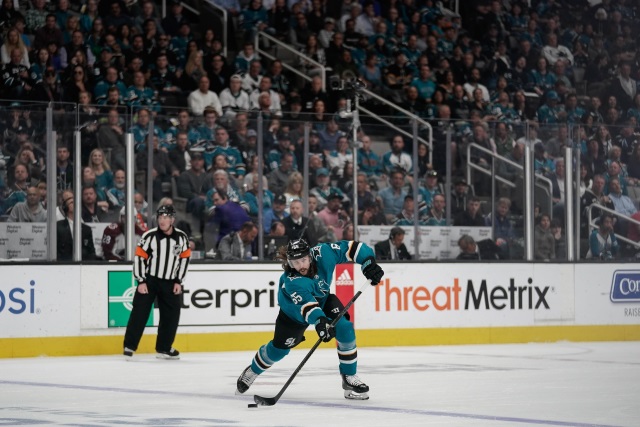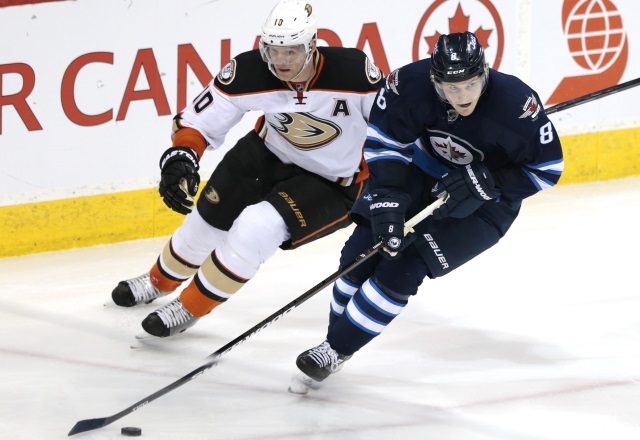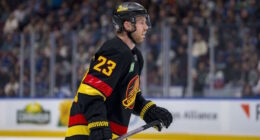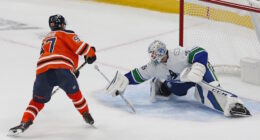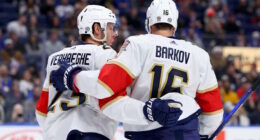Erik Karlsson signed an eight-year, $92 million deal with the San Jose Sharks on Monday. San Jose re-signs the main UFA on the market and keeps their top two defensemen as well. Naturally, there will be fallout but that is for later. Let’s get into the particulars.
First, there is this message from Erik Karlsson himself.
A message from @ErikKarlsson65 to #SharksTerritory! pic.twitter.com/JPjjefKD9S
— San Jose Sharks (@SanJoseSharks) June 17, 2019
Erik Karlsson contract explained
Again, thanks to CapFriendly, contracts are easier to dive into quickly. He earns a whopping $14.5 million for the 2019-20 campaign. The contract breaks down as follows:
- 2019-20 — $14,5 million ($3.5 million base, $11 million bonus)
- 2020-21 — $12 million ($2 million base, $10 million bonus)
- 2021-22 — $14.5 million ($5.5 million base, $9 million bonus)
- 2022-23 — $12 million ($2 million base, $10 million bonus)
- 2023-24 — $11.5 million ($10.5 million base, $1 million bonus)
- 2024-25 — $11 million ($10 million base, $1 million bonus)
- 2025-26 — $9 million ($4 million base, $5 million bonus)
- 2026-27 — $7.5 million ($1.5 million base, $6 million bonus)
First, there is this from a hockey standpoint.
“As far as hockey goes, I’m excited to continue the chase for the ultimate prize: the Stanley Cup. Last year was an unbelievable run but we didn’t achieve what we set out to do. But the dedication I witnessed from my teammates, coaches, staff and organization showed me that we all have a great future ahead of us, and that we are capable of fighting for that championship year in and year out.”
The salary cap hit comes in at $11.5 million AAV for the deal. However, the salary structure is different as seen above. There is $53 million worth of signing bonus compared to a $39 million base salary for the life of the contract. Predictably, 82% of the contract pays out over the first six seasons.
Now, there lies one major wrinkle with this deal. The new pact features a full no-move clause for all eight seasons. That is correct. Erik Karlsson traded or moved will not happen without his say.
The eight years down that long and winding road for Erik Karlsson
Karlsson currently is 29-years old. When the contract ends, Karlsson will be 37 (past his prime likely). The question becomes what happens to San Jose because of this deal.
Doug Wilson presents a bold strategy and has proven he will do what he can to get San Jose its first Stanley Cup title. Signing Erik Karlsson to this kind of deal signifies the risk and reward involved. Also, there are immediate and future concerns with the defenseman that are unique when compared to most situations.
The short-term contract fallout
It is one of the first questions asked. How does San Jose become cap compliant with signing as much of their “core” as they need to? For now, Joe Pavelski and Joe Thornton have not been ruled out as a package signing (big discount possible). The total cap space comes in at $12.543 million for San Jose with 16 players signed.
Joonas Donskoi and Gustav Nyquist are expected to test free agency. Justin Braun and Brenden Dillion become tradeable commodities. However, Braun may be more likely to go as Dillion showed chemistry with Karlsson last season.
What happens to Timo Meier? Does a team attempt an offer-sheet now? These are questions which must be asked.
Furthermore, there are some outside the box methods Doug Wilson could employ. Does he trade a different piece or two of his core to reshuffle the chairs so to speak? Either way, presume a plan is in place and expect a little chaos in San Jose for cap compliance to occur.
Some important notes from a stats perspective
Among other things, we can use the charts from Sean Tierney here to help. Erik Karlsson plays at such an elite level despite the risks.
Karlsson spends 25+ minutes of ice time a night playing all situations. His numbers exist in the off the charts good level. Goal differential per 60 for Karlsson in San Jose was +1.178 goals in 2018-19. That number remains simply absurd. His production rate is lower than Brent Burns by about 25% but so many metrics are just ridiculously good.
Truthfully, if the groin surgery recovery goes well, it will be interesting to see what Karlsson does during the 2019-20 season. He racked up 45 points (just three goals though) in 53 games of the 2018-19 campaign. If Karlsson plays a full year, he could potentially top 70 points.
One other interesting tidbit was the uptick of shots on net. Karlsson averaged 3.2 shots per game last year and that was reminiscent of his high point years in Ottawa. If he does that again this season, projections should be raised accordingly.
The quality chances Karlsson creates is also off the charts and among the top-5 in defensemen. When the blueliner is on his game, there are very few like him…period!
The injurious concerns…but the elite level
The later questions down the line form into this final one. What will Karlsson look like at age 35,36, or 37? San Jose expects to be a very different team in those final years of this contract.
Again, Doug Wilson and San Jose care little about the back half of the contract. Currently, they focus on the front half and the window to win the Stanley Cup. For the sake of conjecture, we quickly delve into it here.
Erik Karlsson plays hockey with half of his ankle bone missing which was replaced with an artificial tendon. This stems from two seasons ago and the heel injury he suffered at the hands of Matt Cooke. No one truly knows what repercussions may come in his later years there.
Also, there is multiple groin injuries and recent groin surgery. Does that eventually influence his career length? That is another uncertainty.
A few closing words…
Certainly, Erik Karlsson plays the game like an elite, Hall-Of-Fame athlete. Risks exist as in every sport but his level of execution is above so many. Karlsson could be at 70% and play better than 90% of his defensive peers.
The front half of this contract is what the defenseman gets judged on going forward and not the back half. Doug Wilson established a window, assembled the talent, made adjustments, and now players like Karlsson must deliver on it.
